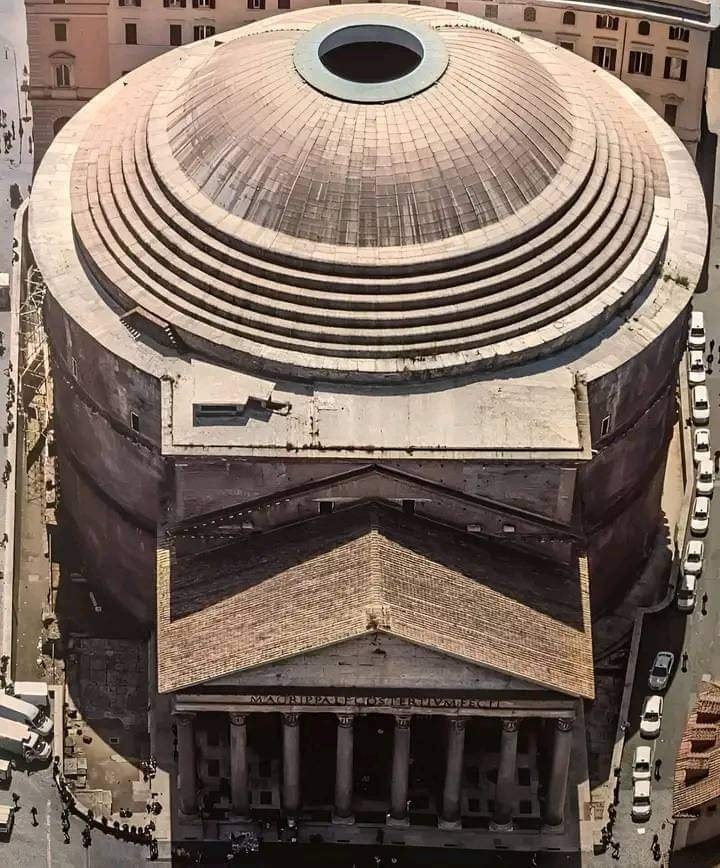The Pantheon, a marvel of ancient architecture, stands proudly in the heart of Rome, embodying both aesthetic splendor and engineering ingenuity. Built nearly two thousand years ago, this architectural masterpiece is more than a structure—it represents a narrative of human innovation that has withstood the tests of time, offering a window into the brilliance of Roman craftsmanship. Its enduring presence is a testament to the advanced knowledge and skills possessed by the Roman builders, whose achievements continue to inspire awe and admiration worldwide.

With perfect symmetry and proportions, the Pantheon’s most striking feature is its massive dome, which measures 43 meters (142 feet) in both diameter and height. This remarkable design not only exemplifies geometric harmony but also holds the distinction of being the largest unreinforced concrete dome in the world, a title it has retained for centuries. Originally dedicated to all Roman gods, or “Pantheon” in Greek, meaning “all gods,” the structure was later converted into a Christian church, ensuring its preservation through the ages. Despite the transformations in its function, the Pantheon’s physical integrity and visual grandeur have remained intact, standing as a living testament to the architectural prowess of ancient Rome.
One of the key factors contributing to the Pantheon’s longevity is the advanced concrete technology developed by Roman engineers. Unlike modern concrete, which can deteriorate over time, Roman concrete possesses remarkable durability and resilience. This innovative material was created by mixing lime, volcanic ash (known as pozzolana), and carefully selected aggregates. The addition of volcanic ash gave the concrete unique properties, enabling it to withstand the elements and even self-heal minor cracks through a chemical reaction with moisture. This pioneering use of concrete allowed Roman builders to construct structures of unprecedented scale and stability, revolutionizing architectural possibilities and setting new standards for construction techniques.
The dome’s design reflects a sophisticated understanding of structural mechanics and material science. To reduce weight while maintaining strength, the dome features a coffered ceiling—an intricate pattern of recessed rectangular panels that not only add visual elegance but also lessen the overall load. Additionally, the composition of the concrete changes as it ascends, with heavier basalt used at the base and lighter pumice incorporated near the top. This strategic gradation ensures that the dome remains stable while minimizing the downward force exerted on the supporting walls. At the apex of the dome is a central oculus, measuring nine meters (30 feet) in diameter. This circular opening serves multiple purposes: it reduces the weight of the dome, allows natural light to illuminate the interior, and symbolically connects the earthly realm with the heavens above. Through this oculus, visitors can witness the interplay of light and space as sunlight streams into the rotunda, creating an ever-changing atmosphere that enhances the building’s spiritual and aesthetic impact.
Beyond its structural achievements, the Pantheon holds immense cultural significance. Its revolutionary design has influenced countless architectural masterpieces throughout history. The dome of Florence’s Santa Maria del Fiore, designed by Filippo Brunelleschi, was directly inspired by the Pantheon’s engineering principles. Similarly, Michelangelo’s design for St. Peter’s Basilica in Vatican City echoes the grandeur of the Pantheon’s dome, as does the dome of the United States Capitol in Washington, D.C. These iconic structures, spanning continents and centuries, bear testament to the Pantheon’s enduring legacy and its profound impact on architectural evolution.
Moreover, the Pantheon’s design demonstrates a remarkable integration of aesthetics and functionality. Every aspect of the structure was carefully planned to achieve both visual harmony and practical efficiency. For instance, the building’s drainage system showcases the foresight and ingenuity of Roman engineers. Rainwater entering through the oculus is swiftly channeled away through a network of concealed drains embedded in the marble floor, preventing water from accumulating within the rotunda. This seamless combination of beauty and functionality reflects the Romans’ holistic approach to architecture, where form and function were inseparable elements of a unified design philosophy.
Throughout its long history, the Pantheon has served as more than just a religious or architectural landmark—it has become a symbol of human achievement and intellectual ambition. Its construction represents a moment in history when human creativity and technical expertise converged to create something truly timeless. The building’s harmonious proportions and innovative construction techniques speak to the Romans’ deep understanding of mathematics, physics, and material science, disciplines that were essential to their architectural success. Even today, the Pantheon continues to captivate visitors with its sheer scale and elegance, evoking a sense of wonder that transcends cultural and temporal boundaries.
The enduring presence of the Pantheon serves as a powerful reminder of humanity’s capacity for innovation and artistic expression. Its walls have witnessed the passage of empires, the evolution of religions, and the unfolding of countless human stories. Yet, despite the changing world around it, the Pantheon stands resolute—a silent witness to the aspirations and achievements of generations past. As visitors step through its ancient bronze doors and gaze upward at the vast expanse of the dome, they are connected to a legacy of creativity and craftsmanship that continues to inspire architects, engineers, and artists to this day.
In essence, the Pantheon is more than just a building; it is a profound narrative of human potential, a testament to what can be achieved through knowledge, vision, and determination. Its dome does not merely shelter those beneath it—it invites them to look upward, to contemplate the infinite possibilities of the human spirit. As the light from the oculus dances across the marble floor, it whispers stories of genius and perseverance, reminding us that true innovation knows no boundaries of time or space. In this way, the Pantheon stands not only as a monument to Rome’s architectural heritage but also as a timeless symbol of humanity’s quest to push beyond the limits of the possible, leaving a legacy that will continue to inspire future generations for centuries to come.





